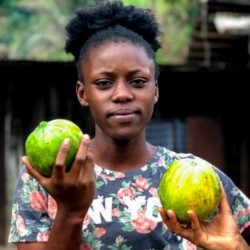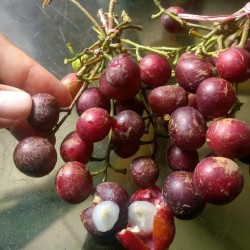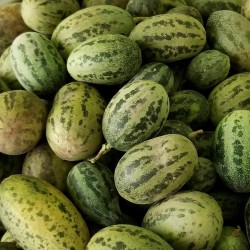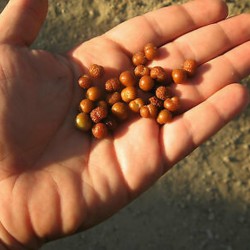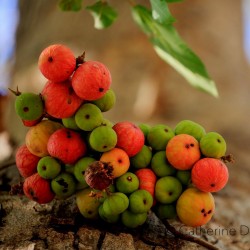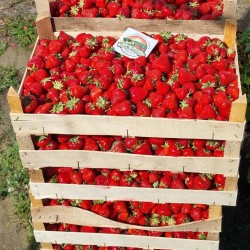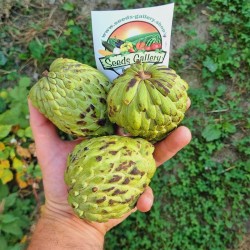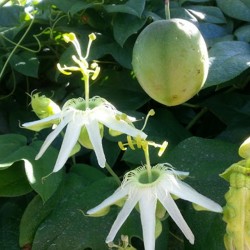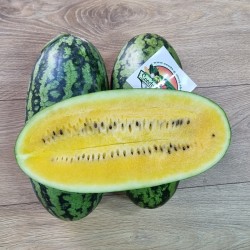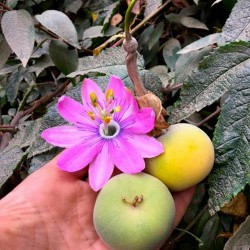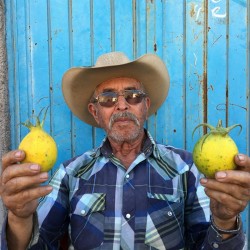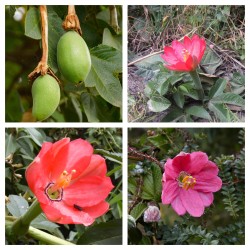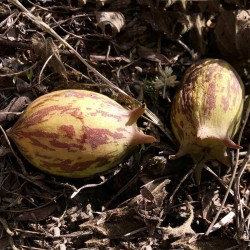
Plant resistant to cold and frost
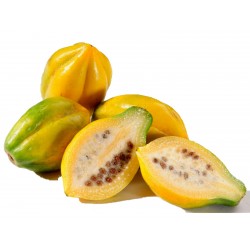
Mountain papaya Seeds...
Price
€3.00
(SKU: V 22 VP)
Seeds Gallery EU,
5/
5
<h2><strong>Mountain papaya Seeds (Carica pubescens)</strong></h2>
<h2><span style="color: #ff0000;"><strong>Price for Package of 5 seeds.</strong></span></h2>
<h3 style="color: #202122; font-size: 14px;">The Mountain Papaya is native to the cooler climates of cloud forests in the Andes between Panama and Chile, to an altitude of up to 3000 m. Apart from being a splendid ornamental, with large, dark green, palmate leaves that have velvety undersides, the female plants produce large quantities of yellow fruits which are traditionally used for preparing beverages and also cooked and eaten. Carica pubescens is best suited to warm temperate climates that lack extremes of heat or cold.<br><br><strong>WKIPEDIA:<br></strong><br>The<span> </span><b>mountain papaya</b><span> </span>(<i>Vasconcellea pubescens</i>) also known as<span> </span><b>mountain pawpaw</b>,<span> </span><b>papayuelo</b>,<span> </span><b>chamburo</b>, or simply "papaya" is a<span> </span><a href="https://en.wikipedia.org/wiki/Species" title="Species" style="color: #0645ad;">species</a><span> </span>of the genus<span> </span><i><a href="https://en.wikipedia.org/wiki/Vasconcellea" title="Vasconcellea" style="color: #0645ad;">Vasconcellea</a></i>, native to the<span> </span><a href="https://en.wikipedia.org/wiki/Andes" title="Andes" style="color: #0645ad;">Andes</a><span> </span>of northwestern<span> </span><a href="https://en.wikipedia.org/wiki/South_America" title="South America" style="color: #0645ad;">South America</a><span> </span>from<span> </span><a href="https://en.wikipedia.org/wiki/Colombia" title="Colombia" style="color: #0645ad;">Colombia</a><span> </span>south to<span> </span><a href="https://en.wikipedia.org/wiki/Central_Chile" title="Central Chile" style="color: #0645ad;">central Chile</a>, typically growing at altitudes of 1,500–3,000 metres (4,900–9,800 ft).</h3>
<p style="color: #202122; font-size: 14px;">It has also been known as<span> </span><i>Carica pubescens.<br><br></i></p>
<p><i>Vasconcellea pubescens</i><span> </span>is an<span> </span><a href="https://en.wikipedia.org/wiki/Evergreen" title="Evergreen" style="color: #0645ad;">evergreen</a><span> </span><a href="https://en.wikipedia.org/wiki/Pachycaul" title="Pachycaul" style="color: #0645ad;">pachycaul</a><span> </span><a href="https://en.wikipedia.org/wiki/Shrub" title="Shrub" style="color: #0645ad;">shrub</a><span> </span>or small<span> </span><a href="https://en.wikipedia.org/wiki/Tree" title="Tree" style="color: #0645ad;">tree</a><span> </span>growing to 10 metres (33 ft) tall.</p>
<div class="thumb tleft">
<div class="thumbinner" style="font-size: 13.16px;"><a href="https://en.wikipedia.org/wiki/File:2011.09-385-158arp_Mountain_papaya(Vasconcellea_pubescens),fr(wh,TS)_Naivasha-Gilgil(Rift_Valley_Prov.),KE_tue13sep2011-1230h.jpg" class="image" style="color: #0645ad;"><img alt="" src="https://upload.wikimedia.org/wikipedia/commons/thumb/d/d5/2011.09-385-158arp_Mountain_papaya%28Vasconcellea_pubescens%29%2Cfr%28wh%2CTS%29_Naivasha-Gilgil%28Rift_Valley_Prov.%29%2CKE_tue13sep2011-1230h.jpg/220px-2011.09-385-158arp_Mountain_papaya%28Vasconcellea_pubescens%29%2Cfr%28wh%2CTS%29_Naivasha-Gilgil%28Rift_Valley_Prov.%29%2CKE_tue13sep2011-1230h.jpg" decoding="async" width="220" height="173" class="thumbimage" srcset="//upload.wikimedia.org/wikipedia/commons/thumb/d/d5/2011.09-385-158arp_Mountain_papaya%28Vasconcellea_pubescens%29%2Cfr%28wh%2CTS%29_Naivasha-Gilgil%28Rift_Valley_Prov.%29%2CKE_tue13sep2011-1230h.jpg/330px-2011.09-385-158arp_Mountain_papaya%28Vasconcellea_pubescens%29%2Cfr%28wh%2CTS%29_Naivasha-Gilgil%28Rift_Valley_Prov.%29%2CKE_tue13sep2011-1230h.jpg 1.5x, //upload.wikimedia.org/wikipedia/commons/thumb/d/d5/2011.09-385-158arp_Mountain_papaya%28Vasconcellea_pubescens%29%2Cfr%28wh%2CTS%29_Naivasha-Gilgil%28Rift_Valley_Prov.%29%2CKE_tue13sep2011-1230h.jpg/440px-2011.09-385-158arp_Mountain_papaya%28Vasconcellea_pubescens%29%2Cfr%28wh%2CTS%29_Naivasha-Gilgil%28Rift_Valley_Prov.%29%2CKE_tue13sep2011-1230h.jpg 2x" data-file-width="3031" data-file-height="2377"></a>
<div class="thumbcaption" style="font-size: 12.3704px;">
<div class="magnify"><a href="https://en.wikipedia.org/wiki/File:2011.09-385-158arp_Mountain_papaya(Vasconcellea_pubescens),fr(wh,TS)_Naivasha-Gilgil(Rift_Valley_Prov.),KE_tue13sep2011-1230h.jpg" class="internal" title="Enlarge" style="color: #0645ad;"></a></div>
A ripe mountain papaya, whole and in cross section (Rift Valley Province, Kenya, September 2011).</div>
</div>
</div>
<p>The<span> </span><a href="https://en.wikipedia.org/wiki/Fruit" title="Fruit" style="color: #0645ad;">fruit</a><span> </span>is 6–15 cm long and 3–8 cm broad, with five broad longitudinal ribs from base to apex; it is green, maturing yellow to orange. The fruit pulp is edible, similar to<span> </span><a href="https://en.wikipedia.org/wiki/Papaya" title="Papaya" style="color: #0645ad;">papaya</a>, and is usually cooked as a vegetable. It is also eaten raw.</p>
<div class="thumb tleft">
<div class="thumbinner" style="font-size: 13.16px;"><a href="https://en.wikipedia.org/wiki/File:Vasconcellea_pubescens.jpg" class="image" style="color: #0645ad;"><img alt="" src="https://upload.wikimedia.org/wikipedia/commons/thumb/5/54/Vasconcellea_pubescens.jpg/220px-Vasconcellea_pubescens.jpg" decoding="async" width="220" height="222" class="thumbimage" srcset="//upload.wikimedia.org/wikipedia/commons/thumb/5/54/Vasconcellea_pubescens.jpg/330px-Vasconcellea_pubescens.jpg 1.5x, //upload.wikimedia.org/wikipedia/commons/thumb/5/54/Vasconcellea_pubescens.jpg/440px-Vasconcellea_pubescens.jpg 2x" data-file-width="1000" data-file-height="1010"></a>
<div class="thumbcaption" style="font-size: 12.3704px;">
<div class="magnify"><a href="https://en.wikipedia.org/wiki/File:Vasconcellea_pubescens.jpg" class="internal" title="Enlarge" style="color: #0645ad;"></a></div>
Leaves of<span> </span><i>Vasconcellea pubescens</i></div>
</div>
</div>
<h2 style="color: #000000; font-size: 1.5em;"><span class="mw-headline" id="Cultivation">Cultivation</span></h2>
<p><i>Vasconcellea pubescens</i><span> </span>is one of the parents of the '<a href="https://en.wikipedia.org/wiki/Babaco" title="Babaco" style="color: #0645ad;">Babaco</a>' papaya, a<span> </span><a href="https://en.wikipedia.org/wiki/Hybrid_(biology)" title="Hybrid (biology)" style="color: #0645ad;">hybrid</a><span> </span><a href="https://en.wikipedia.org/wiki/Cultivar" title="Cultivar" style="color: #0645ad;">cultivar</a><span> </span>widely grown for fruit production in South America, and in subtropical portions of North America.</p>
<p style="color: #202122; font-size: 14px;"><i></i></p>
V 22 VP





